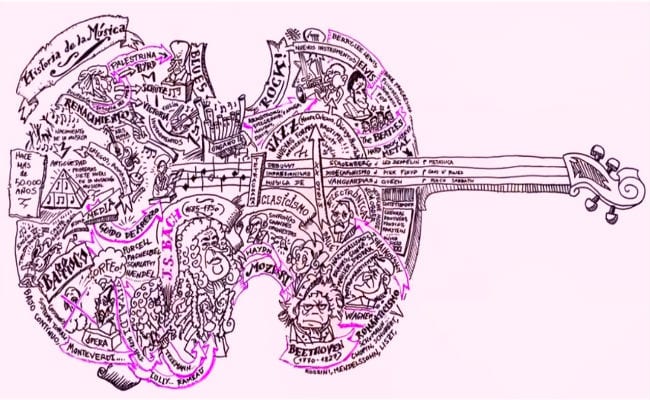Music has traditionally been defined, whatever the kind of music to which reference is made, such as the art of combining sounds and silences with an order, melody and specific rhythms, in the permanent search for the aesthetic sense and influenced by the emotions and the spirit of the author and those who share his aesthetic taste. The evidences of its existence and origins go back to prehistory, although who could imagine the world without music? Although its origin cannot be precisely established with certainty, it is believed that its beginnings can be found in the imitation, by man, of the sounds of nature, the singing of birds, the waves of the sea, the sound of the wind. , among others.
Music is a cultural product like all artistic manifestations And in an evolution of its most basic concept, it could be said that music is the expression of feelings and emotions in the constant search for an awakening of aesthetic sensitivity in the interlocutors that generates pleasure and satisfaction by raising the feeling and emotion to levels. difficult to pinpoint and measure. Since music is a cultural product in which the intervention and expression of multiple factors is evident, it is easy to understand why the types of music are so many, and as diverse as their classifications and performance criteria.

Music classification
Music is a universal language, which transcends the barriers of cultural differences, language, among many other factors that we could use when establishing a classification that allows us to better order and study this art, let's see some of the More managed and accepted criteria when classifying musical genre.
Geographical place of origin
Geographical and cultural factors exert notable influence on the development of the characteristic music of a certain ethnic or social group.
- Greece, in Greece has its origin the western musical genres. This town occupies an important place in the antecedents of the history of music
- Dominican Republic In this region of the Caribbean the representative genus is meringue, it is a kind of music danceable that has subsequently spread to other regions with its own variants of the area that hosts it.
- Asia In this region the stylized style of music predominates, it is characterized by exhibiting varied and very elaborate musical forms.
- Latin America. Latin American music is very rich, extensive and varied, as in almost all regions the genres originate around very specific cultures, customs and events. In this region we find: Salsa, Merengue, Traditional, Cumbia, Vallenato, Ranchera, Northern Band, Tango, Flamenco, Latin Jazz, Samba, Pagode, Sertanejo, and Rock in Spanish
- United States the most prevalent types of music in this region are: Jazz. Country music, Rhythm and Blues and Rock. Techno is a genre of electronic music that emerged in Detroit, USA, in the mid-eighties.
- Cuba Salsa is a musical genre, a rhythm is a musical culture developed by musicians of Cuban origin. As a genre, it encompasses multiple subgenres since salsa is the genesis and synthesis of many other types of music: dance, contradanza, the danzón, the guaracha, the guaguancó, the mambo, the chachachá and the son montuno.
- Japan. With the arrival of Buddhism certain types of music were established in Japan. This is how we find the Bugaku, the name given to the music that accompanies certain dances. Shinto is religious music and Kagen which is a type of music with no specific purpose is simply music for the pleasure of making and hearing music.
According to its Function
Music as a cultural fact arises around the various activities of the human being, so in this category we find the following genres:
- Religious It is music composed specifically to accompany religious services or ceremonies. It is made based on the needs and liturgical requirements or those of the believers or practitioners of a particular religion or cult.
- Profane. This classification encompasses all music intended for various human activities without any link to any dogma of faith.
According to the sound means used.

According to the sound means used, music can be classified into two types: vocal, instrumental and vocal instrumental.
- Vocal music. In this category we find that music interpreted by the voice sung exclusively. Musical works or pieces performed by the human voice, without instrumental accompaniment, are called “a cappella”. In this case the work can be performed by a single person, and in this case the performer is called a soloist, or it can also be sung by a choir or group of people who interpret all voices in the same tone in "unison". and melodic line or in polyphonic form, in variants, generally 1/8 in the musical scale of the same, and tone with different variations from the melodic line.
- Instrumental music. In this genre we find the type of music performed exclusively by instruments. This type of performance can be performed by a single instrument, and in this case we speak of "soloist" or it can be performed by more than one interpreter, with the same type of instrument or with a variety of complementary instruments that together perform an integral work. Of the piece.
- Vocal-instrumental music. It is the variety of music that the integration of voices and instruments counts for its execution.
According to the public to whom it is directed
As music is a cultural fact, born from artistic manifestations, its conception is marked by the characteristics of the human groups that have created it, adapting it to its various purposes. Thus according to this criterion we find:
- Folk or popular music This genre was born as a product of popular manifestations, its essence its work, which is faithfully reflected in each work. Thus, from the text or letter to the musical form, they arise as a direct consequence of popular idiosyncrasy. It includes the works that have arisen over time and that are preserved as a faithful manifestation of the traditional. In this genre, the people are the creator, architect and guarantor of its conservation, which is achieved thanks to the fact that it is transmitted from generation to generation.
- Cult music in this group we find all the cultured, learned, academic or select music. This genre is subject to study and to all kinds of theoretical, aesthetic, and structural considerations. It involves long hours of study and written documentation and its interpreters go through a long and rigorous training process to be able to carry it out.
- Popular music is a set of musical styles that are not identified with specific nations or ethnicities. His representative works are characterized by their simplicity and short duration and for being generally composed in simple musical forms. It does not require a high level of musical training to be performed and is marketed and disseminated thanks to the mass media.
- Electronic music: This type of music arises from the nineties, this genre is based, as the name implies, purely on electronic sounds created in a laboratory
- Music according to the historical period. In this classification we find pieces representatives of historical periods with well-marked characteristics in each of which arose, a musical manifestation, expression of life and feeling of the time. This is how we find:
- Ancient or medieval (1000 to 1400)
- Renaissance (1400 to 1600) this historical period is characterized by the resurgence of the image of man who resurfaces from his encounter with the old and attributes to himself a new creative and artistic force. The music of this period is characterized by polyphony and counterpoint.
- Baroque (1600-1750) arises from the use of complex tones instead of polyphony and counterpoint
- Classicism (1750-1800) is a genre characterized by setting new guidelines in composition and structure. In this period the harpsichord disappears and the piano appears
- Romanticism (1800-1910) music comes to be recognized as part of the cultural task, the creation of musical training establishments (conservatories) is encouraged
- Contemporary XNUMXth century encompasses the post-romantic, modern, and postmodern.